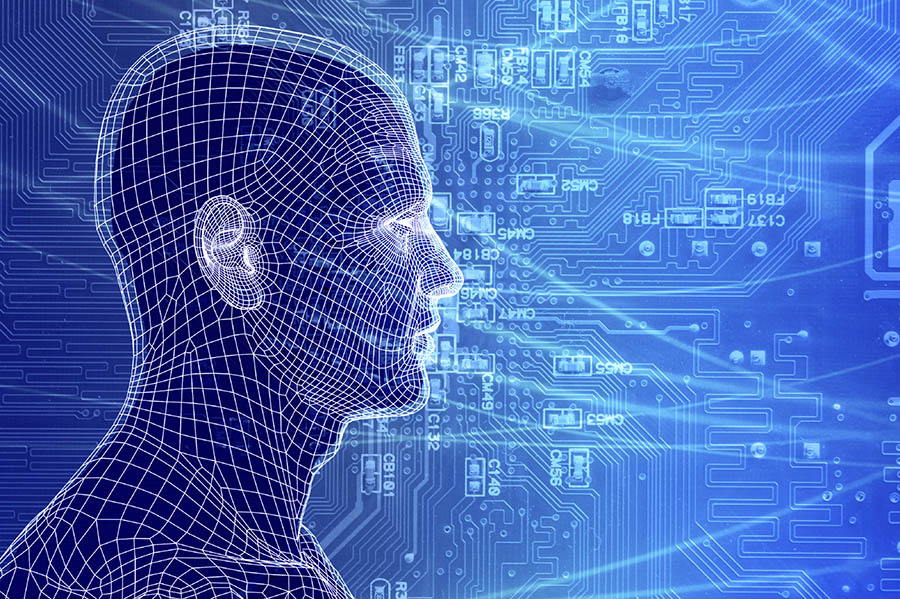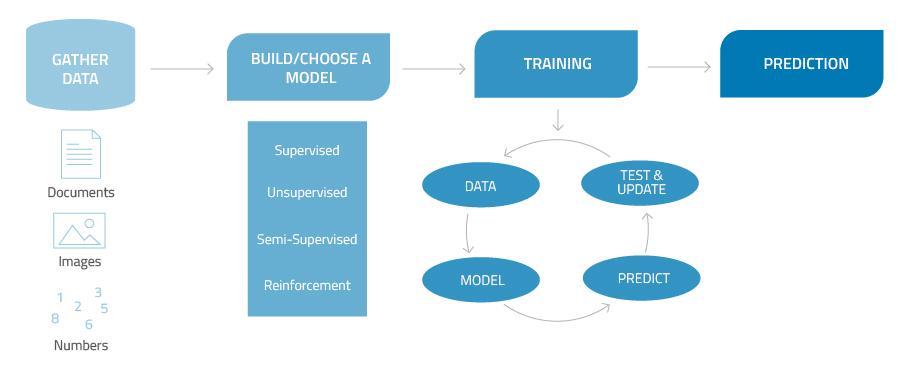Is Your Enterprise Ready to Rise with the Machines?
AI, machine learning bring surge in memory demand

Another industrial revolution is upon us, and it is being driven by a myriad of technologies generating an influx of data. At its core is artificial intelligence (AI) with machines learning to think like humans, and its increasing adoption is altering every facet of society.
What exactly is AI? TechTarget defines AI as "the simulation of human intelligence processes by machines, especially computer systems." These processes include learning, reasoning and self-correction.
AI is already prevalent today, though still probably not in the form often seen in movies. In your daily life, AI is being used to offer recommendations on what to buy online, to recognize biometric features to unlock phones, to understand and respond to questions to virtual assistants, and even filter spam emails, to name a few real-life applications.
According to research by IDC, global spending on cognitive and AI solutions will reach 54.4% compound annual growth rate (CAGR) through 2020. Top use cases include quality management investigation and recommendation systems, diagnosis and treatment systems, automated customer service agents, automated threat intelligence and prevention systems, and fraud analysis and investigation.
Machine Learning and the Algorithm Economy
人工智能(AI)的普及正在改变社会的方方面面,而AI的增长与物联网(IoT)的增长直接相关,特别是在自动化领域,其中越来越多的“事物”在很少或没有人为干预的情况下运行。机器学习是AI的一个分支,它开发了允许计算机学习的技术。深度学习平台是机器学习的一种独特形式,它使用人工神经回路来模拟人脑如何处理数据并创建决策模式。
By observing high volumes of complex data, algorithms "learn" to create better computing models to predict issues, solve problems, improve processes and increase efficiencies—basically, improve lives, societies and businesses.
Forbes lists the top 10 AI and machine learning use cases:
-
Data security – Predicting security breaches and reporting anomalies by observing and establishing patterns in how data in the cloud is accessed
-
Personal security – Identifying things that human screeners might miss during security checks in airports, stadiums, cinemas and other venues
-
Financial trading – Predicting and executing high-speed and high-volume trades
-
Health care – Understanding disease risk factors in large populations, and spotting patterns for early disease prevention
-
Marketing personalization – Helping companies better understand their customers to deliver better, more personalized products and services
-
Fraud detection – Spotting potential cases of fraud and distinguishing between legitimate and fraudulent transactions
-
Recommendations – Analyzing people's activities and preferences to determine what they might like to buy next, and offering purchase recommendations
-
Online search – Detecting patterns based on search queries to provide better search results
-
Natural language processing – Simulating the human ability to understand language and understanding meanings to overcome language barriers
-
Smart cars – Enabling self-driving cars that can understand its environment and make intelligent adjustments to ensure driver, passenger, pedestrian and infrastructure safety
Machine Learning Process
How does a machine learn to think like a human brain? There are essentially four steps, with several components in between.
-
Gather data from multiple valid sources. At the initial stage, there must be enough data to apply machine learning to solve a particular problem. Data is then prepared for machine training by organizing, discovering patterns, and identifying and analyzing relationships.
-
Build or choose a model or machine learning algorithm. Several models exist and the choice will depend largely on the type of machine learning task. There are four types:
Supervised learning refers to the task of inferring a function from training data, where input and output (desired outcome) are clearly labeled.
Unsupervised learning refers to the machine's ability to solve complex problems where training data is not labeled and only input data is used. In a classification problem, for example the machine will recognize objects with similar characteristics, cluster them together and assign its own label.
Semi-supervised learning uses a combination of both labeled and unlabeled data. This is particularly useful when reference data is incomplete or inaccurate. The machine will access reference data when available and fill in gaps with "guesses."
Reinforcement learning is an area of machine learning where there are no labeled or unlabeled data sets. The algorithm learns by interacting with its environment. If it performs correctly, it receives a reward; in incorrectly, it receives a penalty. Over time, the agent maximizes its reward and minimizes penalty using dynamic programming. -
Training. The bulk of machine learning happens at this stage, enabling the algorithm to improve its abilities. Actual algorithm output is then compared with the output it should produce, values are adjusted, and the process is repeated until it becomes adept. Evaluation then follows with the algorithm being tested using data that has not been previously used for training to see how it performs against data it has not seen yet. Parameters are then further tuned.
-
Prediction. At this stage, machine learning derives meaning from data and uses that data to answer questions or solve issues.

Figure 1. Simplified depiction of the machine learning process.
数据作为燃料
这次技术革新是由数据推动的。从自动驾驶汽车到智能工厂、医疗保健、智能家庭和建筑、智能城市等数十亿设备正在产生惊人的数据量。
例如,像Rimac C_Two这样的新型电动超级跑车,拥有最先进的信息娱乐系统、摄像头和众多传感器,这些传感器可以在每小时的驾驶过程中轻松生成数TB的数据。例如一个典型的海上石油平台每天仅产生1 TB到2 TB的数据,一架商用飞机每小时飞行产生40 TB的数据,采矿作业每分钟产生2.4 TB的数据。(来源)
需要存储、处理和检索的数据量正以无法满足的速度不断增加,自然地,需要基础结构来处理大量数据。抛开炒作不谈,对AI现实的发展至关重要的一个计算组件是内存。
内存需求上升
动态随机存取存储器(DRAM)是数据处理的重要组成部分。在数据云、数据应用中心以及边沿计算中产生了大量的数据需要存储,这势必导致空前的DRAM需求。据了解,The Register, Micron CEO Sanjay Mehrotra说" 与标准服务器相比,人工智能服务器将需要比标准服务器多五倍数量的DRAM和一倍数量的SSD。"
随着人工智能工作负载的持续增长,超大规模的数据中心需要越来越多的内存。In the first quarter of the year, DRAM supply remained tight mainly due to the massive construction projects of data centers, some of which are bigger than football fields. IDC defines hyperscale data centers as having "... a minimum of 5,000 servers and are at least 10,000 sq ft in size but generally much larger.” -IDC (2016)
虽然很大一部分AI工作都将用于超大规模数据中心,但是机器学习的增长不再局限于它们,而是随着AI应用的加速而渗透到每个行业。内存基础设施面临的巨大挑战不仅是来自机器和深度学习应用程序的庞大数据量,而且这些数据必须快速移动、处理和存储。
用于AI工作负载的ATP DRAM模块
ATP电子通过其工业级DRAM产品组合满足了对满足AI工作负载要求的更高容量,更高速度和更高可靠性的存储产品的需求。 ATP DRAM模块可满足各种部署方案中对内存带宽的要求。最新的DDR4-2666使加速计算成为可能,其更快的接口速度使理论峰值性能比上一代提高了15%。关键计算应用在提高性能的同时将功耗维持在仅为1.2V的水平。

图2. ATP提供了完整的DRAM解决方案,可满足人工智能和机器学习工作负载不断增长的内存需求
ATP DRAM模块具有不同的密度,速度和外形尺寸,可满足繁重的工作量和恶劣的工作条件。 从SDRAM到DDR4的完整产品线都经过从IC到系统级的严格测试和验证,主要IC均来自1级制造商。 厚30µ“的金手指镀层可确保高质量的信号传输,某些模块可在-40°C至85°C的工业温度范围内工作。
符合JEDEC标准,100%系统级测试和可靠的使用寿命支持,使这些内存模块成为满足AI工作负载的高性能计算要求的理想解决方案。
Visit the ATP DRAM products page for more information about the best memory solutions for your enterprise or industrial needs, or contact an ATP Representative to know how our DRAM modules can meet the exacting demands of your growing enterprise or industrial needs in the emerging age of artificial intelligence.